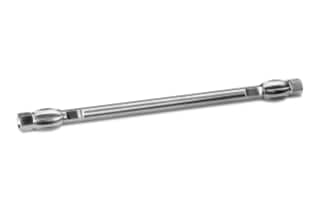
|
Chemistry |
Phenyl |
|
Separation Mode |
Reversed Phase |
|
Particle Substrate |
Hybrid |
|
pH Range Min |
1 pH |
|
pH Range Max |
12 pH |
|
Maximum Pressure |
6000 psi (415 Bar) |
|
Endcapped |
Yes |
|
Bonding Technology |
2-methyl-2-phenylethyl |
|
Silanol Activity |
Low |
|
Particle Shape |
Spherical |
|
Particle Size |
5 µm |
|
Endfitting Type |
Waters |
|
Pore Size |
125 Å |
|
Format |
Column |
|
Surface Area |
175 |
|
System |
HPLC |
|
USP Classification |
L11 |
|
Inner Diameter |
3.9 mm |
|
Length |
150 mm |
|
Carbon Load |
12 % |
|
UNSPSC |
41115709 |
|
Brand |
XTerra |
|
Product Type |
Columns |
|
Units per Package |
1 pk |
XTerra Phenyl Column, 125 Å, 5 µm, 3.9 mm x 150 mm, 1/pk
Your collection of lab supplies should contain the XTerra Phenyl Column, a hybrid-based, reversed-phase column with phenyl ligand functionality. The pH stability of these first-generation Xterra columns is better than that of a silica-based column.
An essential piece of laboratory apparatus, the XTerra Phenyl Column, can add complementary selectivity to straight-chain alkyl stationary phases, particularly for compounds with aromatic rings. Additionally, it offers excellent surface coverage, robust pH stability, consistent retention times, nice peak shapes for all compounds, and reproducible retention times. This is made possible by the effective union of Hybrid Particle Technology with Xterra phenyl chemistry, which produces a special stationary phase with these extraordinary features. Additionally, the XTerra Phenyl Column's di-functional bonding chemistry of the short-chain phenyl ligand enhances the column's low pH hydrolytic stability. Complex mixture separations get a new dimension of selectivity thanks to this unique substrate and ligand.
The packing components for the XTerra Phenyl Column are made using Waters Hybrid Particle Technology. The XTerra particles take advantage of the best of both worlds because they are made of both inorganic (silica) and organic (organosiloxane) components. This hybrid approach offers greater separation efficiency and improved pH stability as compared to reversed-phase packing materials based on silica. Only ultrapure chemicals are used in the production of XTerra Columns in order to regulate the chemical makeup and purity of the Hybrid particle. Each column is separately tested during the production process, and all steps are accomplished within tight tolerances. Certificates of Batch Analysis and Column Efficiency are provided for each column.
The Xterra Columns come in a range of porosity and particle sizes to meet your chromatographic needs. You can find out more about them in our catalog or on our website, and you can shop for lab equipment through either of those two channels.
You may also want to check out XTerra Phenyl VanGuard Cartridge, 125 Å, 5 µm, 3.9 mm x 5 mm, 3/pk; By eliminating particle contamination from the mobile phase stream, XTerra Phenyl VanGuard Cartridges are used to increase analytical column lifetime and performance. All 3.9 mm and 4.6 mm I.D. XTerra Phenyl analytical columns with 5 µm sorbent particles are protected by this cartridge.
What Is The Appearance Of A Phenyl Group?
A phenyl group is composed of a hexagonal planar ring made of a cluster of six carbon atoms, five of which are connected to individual hydrogen atoms and the sixth to a substituent. In organic chemistry, phenyl groups are rather prevalent.